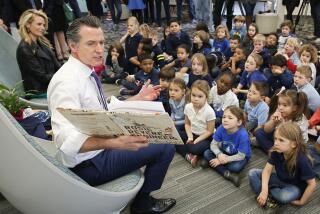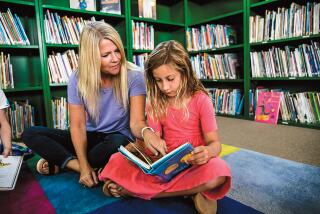Finding a Meaning in Whole-Language : Education: New system of teaching reading emphasizes understanding of context rather than practicing phonics.
âDaddy maced his new car.â
Imagine you are listening to a third grader reading aloud a passage that really says âDaddy raced his new car,â but the child reads âmacedâ for âraced.â
Now imagine another child reading the same passage as âDaddy sped in his new car.â
Which child did a better job of reading, the one who interpreted âracedâ as âmaced,â or the one who understood the meaning and said âsped?â
If you believe the âmacedâ version is better reading, you will probably agree with Prof. Patrick Groffâs critical commentary about the new whole-language approach to reading instruction (Dec. 9).
According to the theory Groff supports, the traditional teacher would not necessarily consider the student who read the verb as âmacedâ a poor reader, but one who needs more practice learning the difference between the letters âmâ and âr.â In addition to giving this reader some work sheets to clarify the problem, the teacher would probably suggest that the student âlook closerâ at the word.
The same teacher would think that the second student has serious reading difficulties since he cannot even tell the difference between the words âracedâ and âsped.â
A whole-language teacher would look at these same students quite differently. The first student would be considered an extremely poor reader, not just someone who needs a little more assistance. This student obviously has learned that it is more important to pay attention to individual words and letters than meaning. The student wants to please the teacher, and the teacher wants each word read as it appears.
Instead of suggesting that the student âlook closer,â a whole-language teacher would say, in effect, âlook biggerâ by asking, âDoes this make sense?â This teacher would think that the student who read the verb as âspedâ is a proficient reader. The meaning is more important to this child than the symbols. The teacher would not even interrupt the childâs reading. There is no need. The child has a good idea of what reading is and no meaning is lost.
We agree with Groff that it is absolutely essential to teach children to read and think critically. With whole language, that is one of the primary goals. So-called traditional methods of teaching reading stress phonics first, then syllables, then words. Meaning is last, which is why so many adults cannot read critically, or, for that matter, even read. They were completely turned off to reading at a very early age, by âdrill-and-skillâ approaches. Teaching young readers to skip unknown words, while using background information, context clues, and knowledge of phonics trains them to cull an understanding of the unknown word.
That is not the same as encouraging âchildren to omit, substitute and insert words in sentences they read--at will,â as Groff charges.
Groff cites sixth-grade scores in reading that are lower than third-grade scores as evidence that students are not learning critical thinking skills. But there is another way of looking at those scores: Whole language is a recent change, and the students more steeped in it are the third-graders, who scored better on the tests.
As to the assertion that the whole-language theory has fared badly when examined experimentally, one has to question what research Groff is reading. If he means research on the ability to decode words in isolation, he may be right, although some of the latest research has shown that even children in whole-language classrooms score well on those tests. If he means comprehension tests, then children in a whole-language classroom understand what they read at an earlier age than those in a phonics-based classroom.
Ask any kindergarten teacher why some of his or her students come to school already reading, and the answer is always that the student was read to at home. Practically none of the parents of these children drilled them with phonics. The research on parental influence on reading skills is conclusive, and there is no debate at all on this issue: children can learn to read by being read to, just as children learn to speak by being spoken to. This is not to say that children have no need for teachers or schooling, just that being read to is the foundation for years of learning from text.
What is today called the whole-language approach is hardly a fad. Reading was taught for hundreds of years using similar methods. The âtraditionalâ phonics approach has only been in existence since the 1920s.
If one wants hard experimental research that shows where phonics-based reading instruction has gotten us, simply look at the plethora of illiterates and dropouts in this country.
More to Read
Sign up for Essential California
The most important California stories and recommendations in your inbox every morning.
You may occasionally receive promotional content from the Los Angeles Times.










